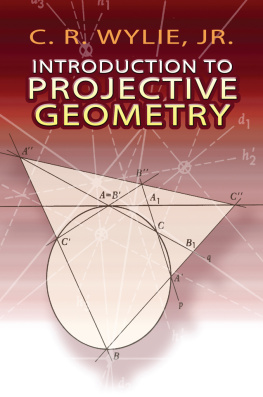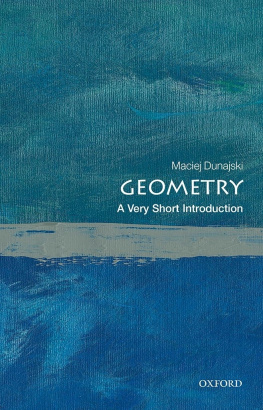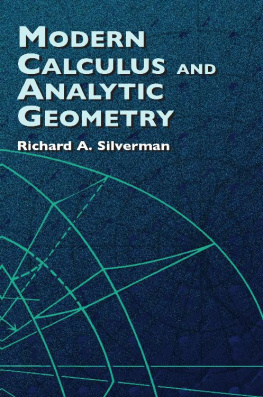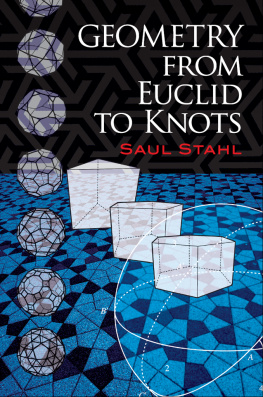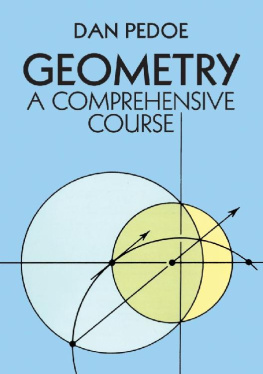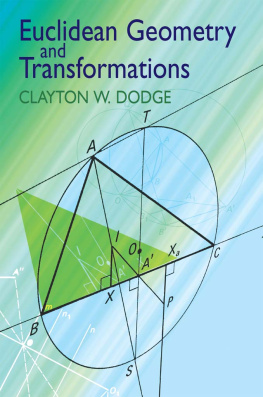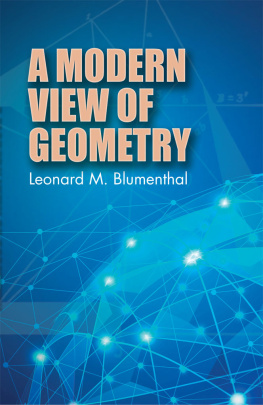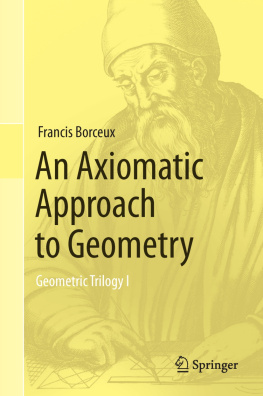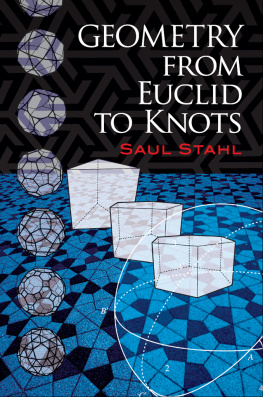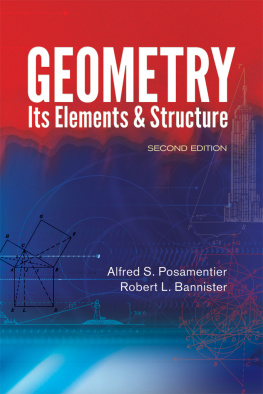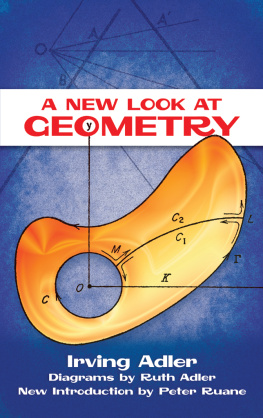Introduction to
PROJECTIVE
GEOMETRY
C. R. Wylie, Jr.
Dover Publications, Inc.
Mineola, New York
Copyright
Copyright 1970 by C. R. Wylie, Jr.
All rights reserved.
Bibliographical Note
This Dover edition, first published in 2008, is an unabridged republication of the work originally published in 1970 by the McGraw-Hill Book Company, Inc., New York.
Library of Congress Cataloging-in-Publication Data
Wylie, Clarence Raymond, 1911
Introduction to projective geometry / C. R. Wylie, Jr.
p. cm.
Originally published: New York : McGraw-Hill, 1970.
Includes index.
eISBN-13: 978-0-4861-41701
ISBN-10: 0-486-46895-X
1. Geometry, Projective. I. Title.
QA471.W95 2008
516'.5dc22
2008028386
Manufactured in the United States of America
Dover Publications, Inc., 31 East 2nd Street, Mineola, N.Y. 11501
The objective of this book is to provide an introduction to plane projective geometry suitable for undergraduate students majoring in mathematics or studying to become teachers of secondary school mathematics.
The material falls naturally into four main subdivisions. The first, consisting only of , is a historical introduction dealing with the elementary aspects of perspective, both in three dimensions, as the artists of the Middle Ages developed it, and in two dimensions, after the process of rabattement has brought the picture plane into coincidence with the object plane.
The second major portion of the book consists of is devoted to a study of linear transformations in the extended plane, first as coordinate transformations, then as point transformations, and the six possible types of nonsingular linear transformations are identified. Then, after the notion of a group is introduced, the affine, similarity, equiareal, and euclidean subgroups of the projective group are investigated.
, the concept of a field is discussed, the arithmetic of collinear points is developed, and an isomorphism between the points of an arbitrary line and the field of complex numbers is postulated. After the general line is thus coordinatized, both nonhomogeneous and homogeneous coordinates are introduced into the projective plane itself, equations are obtained for lines, points, and conics, and the incidence condition for a point and a line is determined.
, euclidean geometry and a curious variant arising from the assumption that the circular points at infinity are real rather than complex are similarly derived. In each case this is done in a more general context than is usual. Specifically, elliptic geometry is developed not from the particular absolute conic x12 + x22 + x32 = 0 but rather from the conic XTaX = 0, where a is an arbitrary positive definite matrix; and hyperbolic geometry is developed not from the particular absolute conic x12 + x22 + x32 = 0 but rather from the conic XTaX = 0, where a is an arbitrary nonsingular indefinite matrix. In the case of euclidean geometry, this generality leads to an infinite number of distance- and angle-measurement formulas, all of which are consistent with the euclidean law of cosines, law of sines, and angle-sum theorem.
The book concludes with two appendixes, the first containing a brief review of the fundamental properties of determinants and the second containing the incidence tables for a nondesarguesian projective geometry with 10 points on each line, together with a number of examples of the curious properties of a geometry in which the theorem of Desargues does not hold.
Although algebraic techniques are used freely throughout this book, its spirit is geometric rather than algebraic. The primary emphasis, of course, is on projective geometry, but with the interests of prospective high school teachers in mind, a serious attempt has been made to clarify the relation of euclidean geometry to projective geometry and to use projective results to illuminate the familiar facts of euclidean geometry. In addition to discussions in the text itself, many of the worked examples and numerous problems have been included for this purpose.
It is the authors hope that most, if not all, of this book will be relatively easy reading for any reasonably well-prepared junior or senior student in mathematics. In an attempt to achieve this clarity of exposition, derivations and proofs have been given in more than usual detail, and a substantial number of completely worked examples and carefully drawn figures have been included. In addition there are over 800 exercises, ranging from routine applications to significant extensions of the theory. As an aid to the student, the answers to the odd-numbered exercises are given at the end of the book.
Any text represents the influence of teachers, colleagues, and students too numerous to list. However, I must acknowledge my indebtedness to the students who used a manuscript edition of this material in my class in projective geometry at the University of Utah during the academic year 1968-1969. Their comments, criticisms, and suggestions were invaluable. I must also express my deep appreciation of the contribution of my wife, Ellen, who assisted me in the tedious work of proofreading.
C. R. Wylie, Jr.
| one |
THE
ELEMENTS
OF
PERSPECTIVE |
1.1 Introduction
The origins of projective geometry, like those of many other branches of mathematics, are to be found in mans concern with the world around him. Unlike her sister disciplines, however, projective geometry grew out of problems which were esthetic rather than practical, and those who contributed to her early development were artists rather than scientists and engineers.
Although the painters of Greece and Rome had tried with some success to give their work a three-dimensional effect, the artists of medieval Europe, preoccupied with religious themes that were mystic rather than realistic, painted in a stiff, highly stylized, starkly two-dimensional fashion. Spatial relations were ignored, backgrounds were neutral, foregrounds were usually missing, and figures whether of trees, animals, or human beings were flat and lifeless. Then toward the end of the thirteenth century, as a revived interest in the cultures of Greece and Rome heralded the dawn of the Renaissance, artists became aware of the unreality of their work and sought consciously to make it more natural and realistic. Duccio (c. 1255-1319) and Giotto (c. 1267-1337), among others, experimented with renderings of space, distance, and shape to suggest the threedimensional relations existing among the objects they painted. Well-defined ground planes were introduced, foreshortening was attempted, and converging lines were used to give an impression of depth.
The intuitive theory of perspective developed by Duccio and Giotto culminated in the fourteenth century in the work of Lorenzetti (c. 1300-1348). Thereafter, further progress in the realistic representation of three-dimensional scenes on the two-dimensional canvas of the painter had to await the development of a mathematical theory of perspective. This came in the fifteenth century, and the men who created it, though in some cases quite competent in the mathematics of their day, were primarily artists. The first of these was Brunelleschi (1379-1446), who by 1425 had developed a system of perspective which he used in his own work and taught to other painters. The first text on perspective, a treatise by Alberti (1404-1472), appeared in 1435. Later Piero della Francesca (c. 1418-1492), a gifted mathematician as well as an outstanding painter, extended considerably the work of Alberti. Still later, both Leonardo da Vinci (1452-1519) and Albrecht Diirer (1471-1528) wrote treatises on perspective which not only presented the mathematical theory of perspective but insisted on its fundamental importance in all painting.
Next page
